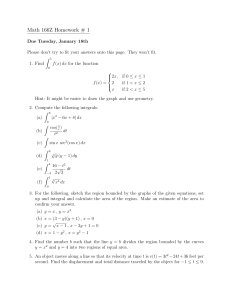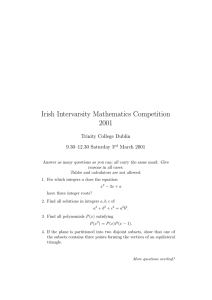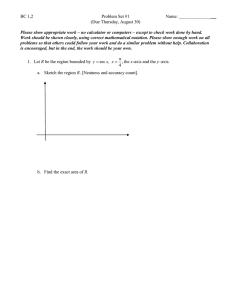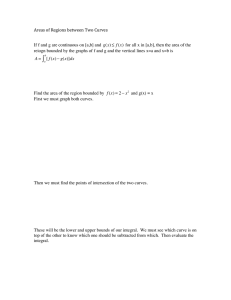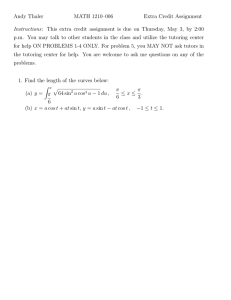Areas Between Curves
advertisement
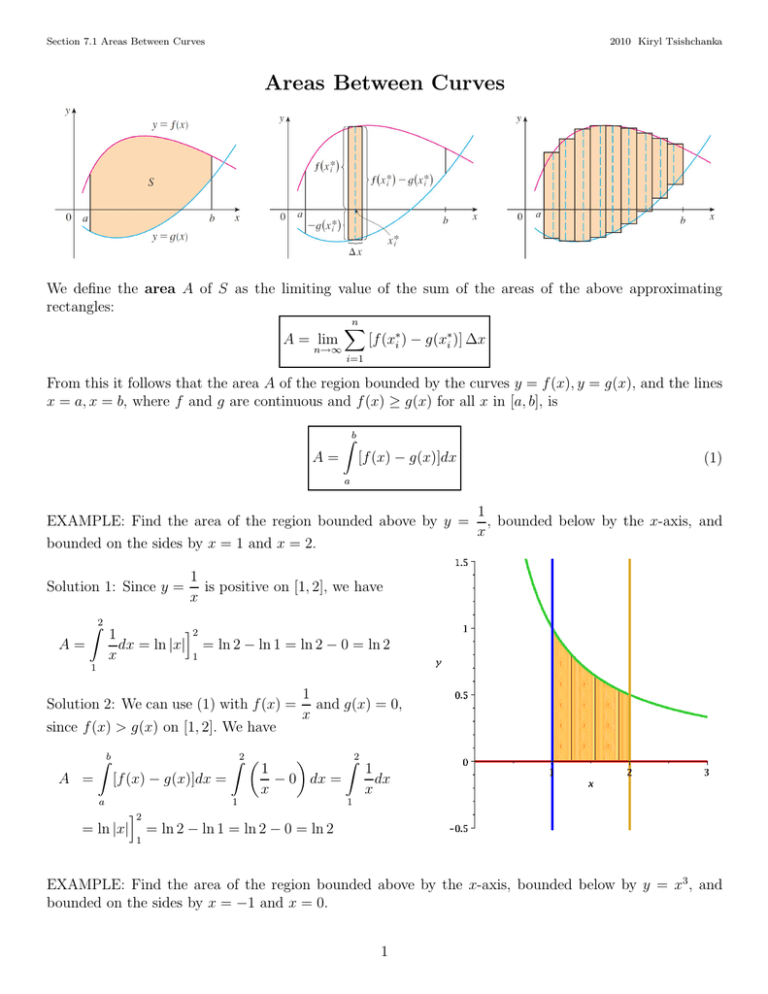
Section 7.1 Areas Between Curves 2010 Kiryl Tsishchanka Areas Between Curves We define the area A of S as the limiting value of the sum of the areas of the above approximating rectangles: n X A = lim [f (x∗i ) − g(x∗i )] ∆x n→∞ i=1 From this it follows that the area A of the region bounded by the curves y = f (x), y = g(x), and the lines x = a, x = b, where f and g are continuous and f (x) ≥ g(x) for all x in [a, b], is A= Zb a [f (x) − g(x)]dx (1) 1 EXAMPLE: Find the area of the region bounded above by y = , bounded below by the x-axis, and x bounded on the sides by x = 1 and x = 2. Solution 1: Since y = A= Z2 1 1 is positive on [1, 2], we have x i2 1 dx = ln |x| = ln 2 − ln 1 = ln 2 − 0 = ln 2 x 1 Solution 2: We can use (1) with f (x) = since f (x) > g(x) on [1, 2]. We have A = Zb a [f (x) − g(x)]dx = = ln |x| Z2 1 i2 1 1 and g(x) = 0, x Z2 1 1 − 0 dx = dx x x 1 = ln 2 − ln 1 = ln 2 − 0 = ln 2 EXAMPLE: Find the area of the region bounded above by the x-axis, bounded below by y = x3 , and bounded on the sides by x = −1 and x = 0. 1 Section 7.1 Areas Between Curves 2010 Kiryl Tsishchanka EXAMPLE: Find the area of the region bounded above by the x-axis, bounded below by y = x3 , and bounded on the sides by x = −1 and x = 0. Solution 1: Since x3 ≤ 0 on [−1, 0], we have A=− Z0 x4 x dx = − 4 3 0 −1 04 (−1)4 1 =− + = 4 4 4 −1 Solution 2: We can use (1) with f (x) = 0 and g(x) = x3 , since f (x) ≥ g(x) on [−1, 0]. We have A = Zb a [f (x) − g(x)]dx = Z0 −1 0 − x3 dx = − Z0 x3 dx −1 0 x4 04 (−1)4 1 =− =− + = 4 −1 4 4 4 EXAMPLE: Find the area of the region bounded by y = x, y = cos x, x = 0, and x = π/6. Solution: We can use (1) with f (x) = cos x and g(x) = x, since f (x) > g(x) on [0, π/6]. We have A = Zb Zπ/6 (cos x − x) dx [f (x) − g(x)]dx = a π/6 0 x2 (π/6)2 02 π = sin x − − − sin 0 − = sin 2 0 6 2 2 1 π2 = − 2 72 EXAMPLE: Find the area of the region bounded by y = 9 − x2 , y = x + 1, x = −1, and x = 2. 2 Section 7.1 Areas Between Curves 2010 Kiryl Tsishchanka EXAMPLE: Find the area of the region bounded by y = 9 − x2 , y = x + 1, x = −1, and x = 2. Solution: We can use (1) with f (x) = 9 − x2 and g(x) = x + 1, since f (x) > g(x) on [−1, 2]. We have A = Zb [f (x) − g(x)]dx = a Z2 −1 Z2 (9 − x2 ) − (x + 1) dx 2 x2 x3 − = 8 − x − x dx = 8x − 2 3 −1 −1 8 1 1 1 39 = 16 − 2 − − −8 − + = 22 − 3 + = 3 2 3 2 2 2 EXAMPLE: Find the area of the region bounded by y = x2 − 2x and y = x + 4. Solution: To find the points of intersection we solve the following equation x2 −2x = x+4 ⇐⇒ x2 −3x−4 = 0 ⇐⇒ (x+1)(x−4) = 0 therefore x = −1, 4. We can use (1) with f (x) = x + 4 and g(x) = x2 − 2x, since f (x) ≥ g(x) on [−1, 4]. We have A = Zb a Z4 [f (x) − g(x)]dx = Z4 −1 (x + 4) − (x2 − 2x) dx 4 x3 3x2 + 4x = −x + 3x + 4 dx = − + 3 2 −1 −1 125 64 1 3 + −4 = = − + 24 + 16 − 3 3 2 6 2 EXAMPLE: Find the area of the region bounded by y = 3 √ x + 3 and y = x+3 . 2 Section 7.1 Areas Between Curves 2010 Kiryl Tsishchanka EXAMPLE: Find the area of the region bounded by y = √ x + 3 and y = x+3 . 2 Solution: To find the points of intersection we solve the following equation 2 x + 3 2 √ √ x+3 1 x+3= x+3 = ⇐⇒ ⇐⇒ x + 3 = (x + 3)2 2 2 4 which can be rewritten as 4(x + 3) − (x + 3)2 = 0 (x + 3)(1 − x) = 0 √ therefore x = −3, 1. We can use (1) with f (x) = x + 3 and x+3 , since f (x) ≥ g(x) on [−3, 1]. We have g(x) = 2 A= Zb a ⇐⇒ [f (x) − g(x)]dx = Z1 √ x+3 x+3− 2 dx −3 1 (x + 3)2 2 3/2 = (x + 3) − 3 4 −3 4 16 = − 4 − (0 − 0) = 3 3 EXAMPLE: Find the area of the region bounded by y = 4 √ x, y = x , and x = 5. 2 Section 7.1 Areas Between Curves 2010 Kiryl Tsishchanka EXAMPLE: Find the area of the region bounded by y = √ x, y = x , and x = 5. 2 Solution: To find the points of intersection we solve the following equation √ 2 x 2 √ 1 x ⇐⇒ ⇐⇒ x = x2 x= x = 2 2 4 which can be rewritten as x2 − 4x = 0 ⇐⇒ x(x − 4) = 0 therefore x = 0, 4. Note that x √ ≥ x on [4, 9]. Therefore 2 A = Z4 0 √ x dx + x− 2 2 2 x = x3/2 − 3 4 4 Z5 4 √ x ≥ x on [0, 4] and 2 x √ − x dx 2 x2 2 3/2 + − x 4 3 0 5 4 √ 107 − 40 5 = 12 EXAMPLE: Find the area of the region bounded by y = sin x, y = cos x, x = 0, and x = π/2. Solution: The points of intersection occur when sin x = cos x, that is, when x = π/4 (since 0 ≤ x ≤ π/2). Observe that cos x ≥ sin x when 0 ≤ x ≤ π/4 but sin x ≥ cos x when π/4 ≤ x ≤ π/2. Therefore the required area is Zπ/2 | cos x − sin x|dx A = 0 Zπ/2 Zπ/4 π/2 + [− cos x − sin x]π/4 = (cos x − sin x)dx + (sin x − cos x)dx = [sin x + cos x]π/4 0 0 = π/4 √ 1 1 1 1 √ + √ − 0 − 1 + −0 − 1 + √ + √ = 2 2−2 2 2 2 2 EXAMPLE: Find the area enclosed by the line y = x − 1 and the parabola y 2 = 2x + 6. 5 Section 7.1 Areas Between Curves 2010 Kiryl Tsishchanka EXAMPLE: Find the area enclosed by the line y = x − 1 and the parabola y 2 = 2x + 6. Solution 1: By solving the equation y2 − 6 y+1= 2 we find that the points of intersection are (−1, −2) and (5, 4). We solve the equation of the parabola for x and notice from the picture that the left and right boundary curves are 1 xL = y 2 − 3 and xR = y + 1 2 We must integrate between the appropriate y-values, y = −2 and y = 4. Thus A = Z4 Z4 Z4 1 2 1 2 (xR − xL )dy = (y + 1) − y − 3 dy = − y + y + 4 dy 2 2 −2 −2 3 2 y 1 y + + 4y = − · 2 3 2 −2 4 = −2 1 4 − · 64 + 8 + 16 − + 2 − 8 = 18 6 3 Solution 2: We can find the area by integrating with respect to x instead of y, but the calculation is much more involved: Z5 Z−1 √ √ √ A = [ 2x + 6 − (− 2x + 6)]dx + [ 2x + 6 − (x − 1)]dx −1 −3 =2 Z−1 √ 2x + 6dx + −3 1 = 2 (2x + 6)3/2 3 Z5 √ [ 2x + 6 − x + 1]dx −1 5 1 x2 3/2 + (2x + 6) − +x = 18 3 2 −3 −1 −1 6

